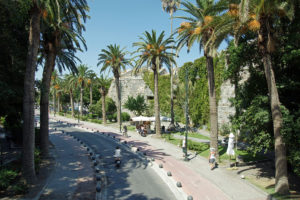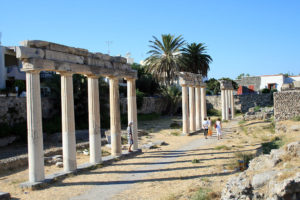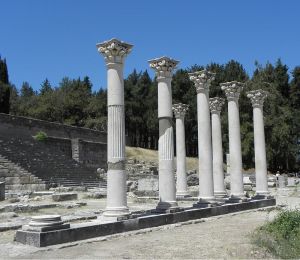

Kos or Cos (Greek: Κως) is a Greek island of the group of the Dodecanese.
Name
The name Kos (Greek: Κῶς) is first attested in the Iliad, and has been in continuous use since. Other ancient names include Meropis, Cea, and Nymphaea.
History
In Homer’s Iliad, a contingent from Kos fought for the Greeks in the Trojan War.

In the Roman mythology, the island was visited by Hercules.
The island was originally colonised by the Carians. The Dorians invaded it in the 11th century BC, establishing a Dorian colony with a large contingent of settlers from Epidaurus, whose Asclepius cult made their new home famous for its sanatoria. The other chief sources of the island’s wealth lay in its wines and, in later days, in its silk manufacture.
Its early history–as part of the religious-political amphictyony that included Lindos, Kamiros, Ialysos, Cnidus and Halicarnassus, the Dorian Hexapolis (Greek for six cities),–is obscure. At the end of the 6th century, Kos fell under Achaemenid domination but rebelled after the Greek victory at the Battle of Mycale in 479. During the Greco-Persian Wars, before it twice expelled the Persians, it was ruled by Persian-appointed tyrants, but as a rule it seems to have been under oligarchic government. In the 5th century, it joined the Delian League, and, after the revolt of Rhodes, it served as the chief Athenian station in the south-eastern Aegean (411–407). In 366 BC, a democracy was instituted. In 366 BC, the capital was transferred from Astypalaia to the newly built town of Kos, laid out in a Hippodamian grid. After helping to weaken Athenian power, in the Social War (357-355 BC), it fell for a few years to the king Mausolus of Caria.

Proximity to the east gave the island first access to imported silk thread. Aristotle (384 BC-322 BC)[clarification needed] mentions silk weaving conducted by the women of the island. Silk production of garments was conducted in large factories by women slaves.
In the Hellenistic age, Kos attained the zenith of its prosperity. Its alliance was valued by the kings of Egypt, who used it as a naval outpost to oversee the Aegean. As a seat of learning, it arose as a provincial branch of the museum of Alexandria, and became a favorite resort for the education of the princes of the Ptolemaic dynasty. During the hellenistic age, there was a medical school; however, the theory that this school was founded by Hippocrates (see below) during the classical age is an unwarranted extrapolation. Among its most famous sons were the physician Hippocrates, the painter Apelles, the poets Philitas and, perhaps, Theocritus.

Diodorus Siculus (xv. 76) and Strabo (xiv. 657) describe it as a well-fortified port. Its position gave it a high importance in Ægean trade; while the island itself was rich in wines of considerable fame. Under Alexander III of Macedon and the Egyptian Ptolemies(from 336 BC) the town developed into one of the great centers in the Ægean; Josephus quotes Strabo to the effect that Mithridates was sent to Kos to fetch the gold deposited there by the queen Cleopatra of Egypt. Herod is said to have provided an annual stipend for the benefit of prize-winners in the athletic games,[20] and a statue was erected there to his son Herod the Tetrarch (“C. I. G.” 2502 ). Paul briefly visited here according to Acts 21:1.
Except for occasional incursions by corsairs and some severe earthquakes, the island has rarely had its peace disturbed. Following the lead of its larger neighbour, Rhodes, Kos generally displayed a friendly attitude toward the Romans; in 53 AD it was made a free city. Lucian (125–180) mentions their manufacture of semi-transparent light dresses, a fashion success.

Ancient Agora
The ancient market place of Kos was considered one of the biggest in the ancient world. It was the commercial and commanding centre at the heart of the ancient city. It was organized around a spacious rectangular yard 50 metres (160 ft) wide and 300 metres (980 ft) long. It began in the Northern area and ended up south on the central road (Decumanus) which went through the city. The northern side connected to the city wall towards the entrance to the harbour. Here there was a monumental entrance. On the eastern side there were shops. In the first half of the 2nd century BC, the building was extended toward the interior yard. The building was destroyed in an earthquake in 469 AD.
In the southern end of the Market, there was a round building with a Roman dome and a workshop which produced pigments including “Egyptian Blue”. Coins, treasures, and copper statues from Roman times were later uncovered by archeologists. In the western side excavations led to the findings of rooms with mosaic floors which showed beastfights, a theme quite popular in Kos.
Source Wikipedia.
Be the first to comment